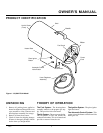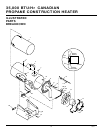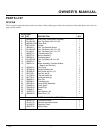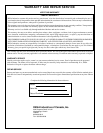
5
103907
OWNER’S MANUAL
OPERATION
WARNING: Review and under-
stand the warnings in the Safety
Information section, page 2. They
are needed to safely operate this
heater. Follow all local codes
when using this heater.
4. Plug extension cord into a 120 volt/60
hertz, 3-hole, grounded outlet. Motor
will start. Fan will turn, forcing air out
front of heater.
5. Open propane supply valve on propane
tank(s) slowly.
Note
: If not opened slowly, excess-flow
check valve on propane tank may stop
gas flow. If this happens, close propane
supply valve and open again slowly.
To Start Heater
1. Follow all installation, ventilation, and
safety information.
2. Locate heater on stable and level
surface. Make sure strong drafts do not
blow into front or rear of heater.
3. Plug power cord of heater into a three-
prong, grounded extension cord.
Extension cord must be at least six feet
(2 m) long. Extension cord must be UL/
CSA listed.
Extension Cord Wire Size
Requirements
Up to 50 feet (15 m) long, use 18 AWG
rated cord.
51 to 100 feet (16 to 30 m) long, use 16
AWG rated cord.
101 to 200 feet (31 to 60 m) long, use
14 AWG rated cord.
Figure 5 - Automatic Control Valve Button
and Piezo Ignitor Button
Notice: If heater is unplugged or power
outage occurs while heater is running, the
thermal limit device will stop fuel flow. A
few seconds occur before the thermal limit
device activates. During this short time,
flames may appear outside the heater. This
is normal. The flames will go out when
thermal limit device activates.
WARNING: Be sure motor and
fan are running before pushing
in automatic control valve but-
ton. Flames could flash outside
heater if motor and fan are not
running.
6. Push in and hold automatic control
valve button (see Figure 5). Push piezo
ignitor button (see Figure 5). You may
need to push piezo ignitor button 3-8
times until the burner lights. When
burner lights, keep automatic control
valve button pushed in. Release button
after 30 seconds.
Piezo
Ignitor
Button
Automatic
Control Valve
Button
To Stop Heater
1. Tightly close propane supply valve on
propane tank(s). Allow heater to burn
remaining fuel in hose.
2. Wait a few seconds. Heater will burn
gas left in supply hose.
3. Unplug heater.
To Restart Heater
1. Wait five minutes after stopping heater.
2. Repeat steps under To Start Heater.
STORAGE
1. Store propane tank(s) in safe manner.
See Chapter 5 of Standard for Storage
and Handling of Liquefied Petroleum
Gases, ANSI/NFPA 58 and/or CAN/
CGA B149.2. Follow all local codes.
Always store propane tanks outdoors.
CAUTION: Disconnect heater
from propane supply tank(s).
Note
: If heater fails to ignite, hose may
have air in it. If so, keep automatic
control valve button pressed and wait
20 seconds. Release automatic control
valve button and wait 20 seconds for
unburned fuel to exit heater. Repeat step 6.
2. Place plastic cover caps over brass
fittings on inlet connector and hose/
regulator assembly.
3. Store in dry, clean, and safe place. Do
not store hose/regulator assembly
inside heater combustion chamber.
4. When taking heater out of storage,
always check inside of heater. Insects
and small animals may place foreign
objects in heater. Remove motor and
other internal parts if needed to remove
foreign objects (see Service Procedures,
page 7).
MAINTENANCE
WARNINGS
• Never service heater while it is
plugged in, connected to pro-
pane supply, operating, or hot.
Severe burns and electrical
shock can occur.
• Keep heater clear and free from
combustible materials, gaso-
line, and other flammable va-
pors and liquids.
• Do not block the flow of com-
bustion or ventilation air.
1. Keep heater clean. Clean heater
annually or as needed to remove dust
and debris. If heater is dirty or dusty,
clean heater with a damp cloth. Use
household cleaners on difficult spots.
2. Inspect heater before each use. Check
connections for leaks. Apply mixture
of liquid soap and water to connections.
Bubbles forming show a leak. Correct
all leaks at once.
3. Inspect hose/regulator assembly before
each use. If hose is highly worn or cut,
replace.
4. Have heater inspected yearly by a
qualified service agency.
5. Keep inside of heater free from
combustible and foreign objects.
Remove motor and other internal parts
if needed to clean inside of heater (see
Service Procedures, page 7.
6. Clean fan blades each season or as
needed (see Fan, page 8).


















